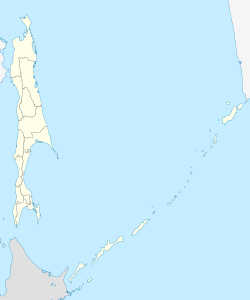Korsakov (town)
| Korsakov (English) Корсаков (Russian) |
|
|---|---|
| - Town - | |
 |
|
 Location of Sakhalin Oblast in Russia |
|
|
|
|
|
|
|
|
|
|
| Administrative status (as of December 2011) | |
| Country | Russia |
| Federal subject | Sakhalin Oblast |
| Administrative district | Korsakovsky District |
| Administrative center of | Korsakovsky District |
| Municipal status (as of July 2012) | |
| Urban okrug | Korsakovsky Urban Okrug |
| Administrative center of | Korsakovsky Urban Okrug |
| Mayor | Lada Mudrova |
| Statistics | |
| Population (2010 Census) | 33,526 inhabitants |
| Time zone | MAGT (UTC+11:00) |
| Founded | 1853 |
| Postal code(s) | 694020 |
| Dialing code(s) | +7 42435 |
|
|
|
| on | |
Korsakov (Russian: Корса́ков; Japanese: コルサコフ (大泊町)) is a town and the administrative center of Korsakovsky District of Sakhalin Oblast, Russia, located 42 kilometers (26 mi) south from Yuzhno-Sakhalinsk, at the southern end of Sakhalin Island, on the coast of the Salmon Cove in the Aniva Bay. Population: 33,526 (2010 Census);36,652 (2002 Census);45,096 (1989 Census)..
Little is known of the early history of Korsakov. The site was once home to an Ainu fishing village called Kushunkotan (in Russian sources, Tamari-Aniva), which was frequented by traders of the Matsumae clan from as early as 1790. On September 22, 1853, a Russian expedition, commanded by Gennady Nevelskoy, raised the Russian flag at the settlement and renamed it "Fort Muravyovsky", after Governor-General of Eastern Siberia Nikolay Muravyov. Nevelskoy left detailed recollections of the landing. He encountered a predominantly Ainu population (at least 600 people; another source mentions only 300 Ainu inhabitants) as well as Japanese nationals who, judging by Nevelskoy's account, exercised authority over the native inhabitants. At the time of Nevelskoy's arrival, the village featured several standing structures—Nevelskoy calls them "sheds"—and even a Japanese religious temple. The villagers supposedly welcomed the Russians after they learned about their mission (protecting them from foreign incursion). Of course, the veracity of this account is in doubt, both because Nevelskoy had ulterior motives for claiming that he was "welcomed" by the inhabitants, and also because it is not clear to what extent the Russians were able to make themselves understood. The Russians abandoned the settlement on May 30, 1854, allegedly because their presence there, at the time of the Crimean War, raised the specter of Anglo-French attack, but returned in August 1869, now renaming the town "fort Korsakovsky," in honor of then-Governor General of Eastern Siberia Mikhail Korsakov. Lingering territorial conflict between Japan and Russia has polarized scholarly opinion of Korsakov's early history, as each side tries to claim priority of early settlement to back up their respective territorial claims in the broader region. In 1875, the whole Sakhalin including the village was ceded to Russia, under the Treaty of Saint Petersburg.
...
Wikipedia


